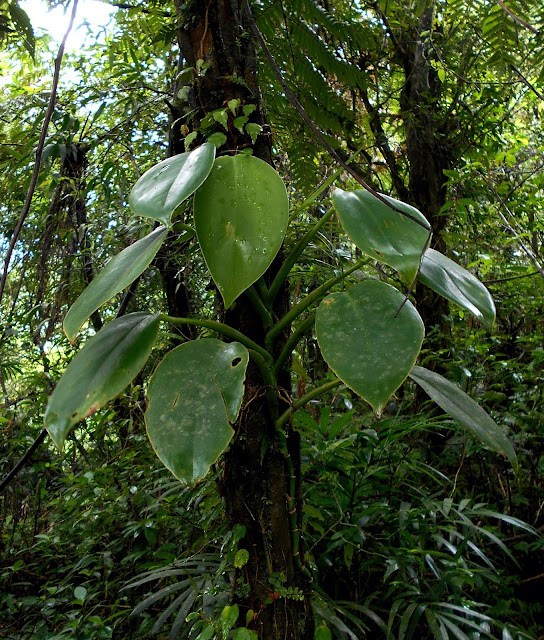The unusual and majestic Rhaphidophora monticola
The current popularity of aroids around the world has brought into spotlight several previously obscure species of the species-rich Anthurium as well as Philodendron and Monstera. This triumvirate of Neotropical aroids form the bulk of Araceae found in very many private collections worldwide, but monsteroid genera from Asia, particularly Rhaphidophora, are increasingly being regarded as worthwhile subjects too, especially the widespread and very variable R. korthalsii. In the Philippines, one species stands out among all the other known species to date, but is virtually unknown in horticultural circles- R. monticola.
Rhapidophora monticola was described (as 'Rapidophora monticola') in 1910 by Kurt Krause in Botanische Jahrbucher fur Systematik, Pflanzengeschichte und Pflanzengeographie (Botanical Yearbook for Systematics, Plant History and Plant Geography) based from specimens collected by A.D.E. Elmer in Cuernos Mountains in Dumaguete, Negros Oriental in June, 1908. The species name 'monticola' refers to the species' preference for mountainous habitats. R. monticola is recorded from 140 to 1200 m altitudes. Link below shows a digital photo of the type:
http://apps.kew.org/herbcat/detailsQuery.do?imageId=5046&pageCode=1&presentPage=1&queryId=1&sessionId=E921AADEA6B803586A3B7EE49779D5DB&barcode=K000291776
Apart from Negros Oriental, the species is also distributed in the provinces of Aurora, Laguna and Sorsogon (Luzon), as well as on the island of Leyte and Surigao del Sur (Mindanao).
Below are photos of R. monticola in its habitat at about 900 m in lower montane forest.
 |
Peter Boyce, in his 'The Genus Rhaphidophora Hassk. (Araceae-Monsteroideae-Monstereae) in the Philippines (2000)' noted: "A species of extraordinary appearance immediately recognizable by the texture and dense venation of the leaf laminas and by the remarkably elongated and robust peduncle, the latter being unique in the genus. It is not at all clear to what Rhaphidophora monticola is related."
Additionally, he wrote: "There is nothing in the Philippines with which to confuse R. monticola either in the fertile state, when the very long peduncle is diagnostic, or when sterile, in which instance the unique leaf venation is unmistakable." Earlier on in the paper, Peter mentioned that "R. monticola is an enigma. In the fertile condition it is morphologically distinct from any other species of Rhaphidophora, while the leaf, especially in the lamina venation, resembles R. philippinensis. The extraordinarily long peduncle and the uniform pale yellow-brown colour of dried material renders it instantly recognizable and distinct." The very long inflorescence peduncle may be an adaptation to better advertise the flowers to potential pollinators especially in dense, misty forests. A photo of the inflorescence can be seen here:
http://www.phytoimages.siu.edu/imgs/pelserpb/r/Araceae_Rhaphidophora_monticola_86662.html
 |
| Photo shows the numerous secondary veins. Private collection. |
Rhaphidophora monticola, in my observations, reaches its largest dimensions at lower altitudes, where the petioles can attain lengths of well over a meter(!) and leaf blades to 80 cm long x 41 cm in width. The paddle-like leaves are stiff, glossy, and smooth. In mossy forests, the species is notably smaller, but this may be a reflection of the general lack of tall trees in higher mountain habitats. Photo below shows a very large specimen at about 300 m altitude. The fraying of the leaves was caused by the rapid clearing of the habitat for agricultural use; in the absence of sufficient forest cover, the foliage is made prone to the lashing of high winds particularly during typhoons.
An extremely rare species in private collections and botanical gardens, R. monticola makes for a spectacular specimen plant in advanced and specialist collections. One thing to keep in mind, particularly for those in hot, low-lying areas, is that this species is best grown if not exposed to very high temperatures for extended periods of time. Its preferred conditions make it suitable more for subtropical climates but can be adapted to more tropical climes, but this is better left for those with more experience. I have a few specimens at home and hopefully, these will be propagated with enough numbers so that this majestic species can be made available to a wider audience in due time.







Can I have a clipping? I have fallen madly in love with this stunning plant. So much beaty in the Philippines.
ReplyDeleteHello, where are u from? Maybe I can give you some
Deletehello, i have purchased this plant yesterday on a good potting soil with husk. What is the best condition for this plant. Will it suit a partial sunny place or should it be kept on a shaded area?
ReplyDeleteI bought a stem a few months ago and it has grown to this extremely long vine but no leaves! Any idea why that may be?
ReplyDeleteI hope you make a video about this plant please. Thank you!
ReplyDeleteHi! is it possible to know the exact location where this can be found? for research purposes only please
ReplyDelete